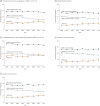Trends in smoking among adults with mental illness and association between mental health treatment and smoking cessation
- PMID: 24399556
- PMCID: PMC5555156
- DOI: 10.1001/jama.2013.284985
Trends in smoking among adults with mental illness and association between mental health treatment and smoking cessation
Abstract
Importance: Significant progress has been made in reducing the prevalence of tobacco use in the United States. However, tobacco cessation efforts have focused on the general population rather than individuals with mental illness, who demonstrate greater rates of tobacco use and nicotine dependence.
Objectives: To assess whether declines in tobacco use have been realized among individuals with mental illness and examine the association between mental health treatment and smoking cessation.
Design, setting, and participants: Use of nationally representative surveys of noninstitutionalized US residents to compare trends in smoking rates between adults with and without mental illness and across multiple disorders (2004-2011 Medical Expenditure Panel Survey [MEPS]) and to compare rates of smoking cessation among adults with mental illness who did and did not receive mental health treatment (2009-2011 National Survey of Drug Use and Health [NSDUH]).The MEPS sample included 32,156 respondents with mental illness (operationalized as reporting severe psychological distress, probable depression, or receiving treatment for mental illness) and 133,113 without mental illness. The NSDUH sample included 14,057 lifetime smokers with mental illness.
Main outcomes and measures: Current smoking status (primary analysis; MEPS sample) and smoking cessation, operationalized as a lifetime smoker who did not smoke in the last 30 days (secondary analysis; NSDUH sample).
Results: Adjusted smoking rates declined significantly among individuals without mental illness (19.2% [95% CI, 18.7-19.7%] to 16.5% [95% CI, 16.0%-17.0%]; P < .001) but changed only slightly among those with mental illness (25.3% [95% CI, 24.2%-26.3%] to 24.9% [95% CI, 23.8%- 26.0%]; P = .50), a significant difference in difference of 2.3% (95% CI, 0.7%-3.9%) (P = .005). Individuals with mental illness who received mental health treatment within the previous year were more likely to have quit smoking (37.2% [95% CI, 35.1%-39.4%]) than those not receiving treatment (33.1% [95% CI, 31.5%-34.7%]) (P = .005).
Conclusions and relevance: Between 2004 and 2011, the decline in smoking among individuals with mental illness was significantly less than among those without mental illness, although quit rates were greater among those receiving mental health treatment. This suggests that tobacco control policies and cessation interventions targeting the general population have not worked as effectively for persons with mental illness.
Conflict of interest statement
Figures

References
-
- Lasser K, Boyd JW, Woolhandler S, Himmelstein DU, McCormick D, Bor DH. Smoking and mental illness: a population-based prevalence study. JAMA. 2000;284(20):2606–2610. - PubMed
-
- Grant BF, Hasin DS, Chou SP, Stinson FS, Dawson DA. Nicotine dependence and psychiatric disorders in the United States: results from the national epidemiologic survey on alcohol and related conditions. Arch Gen Psychiatry. 2004;61(11):1107–1115. - PubMed
-
- Ziedonis DM, Kosten TR, Glazer WM, Frances RJ. Nicotine dependence and schizophrenia. Hosp Community Psychiatry. 1994;45(3):204–206. - PubMed
Publication types
MeSH terms
Grants and funding
LinkOut - more resources
Full Text Sources
Other Literature Sources
Medical

